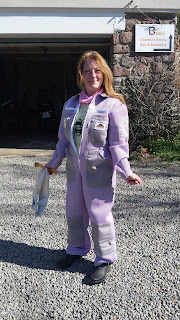Anyone who keeps bees knows that at some point, hopefully ‘later’ rather than ‘sooner’, (but almost never ‘never’!) they will be stung. Honey bees are not usually aggressive, but they are sensitive to being disturbed, and can quickly feel threatened by the presence of anything that distracts them from their work. Their reaction is to defend the colony and this often includes deploying their stings. It’s not true that all bees die when they sting – if they can retract the barb, the mechanism by which the venom is delivered, they’ll live, but often the barb is fatally ripped out of their bodies. Being stung therefore isn’t great for the bee or the person being stung and so it makes sense to disturb them as little as possible and for us to wear adequate protective clothing when we do want to be working with our bees.
Luckily there are several options when it comes to choosing an outfit, including style, colours, fit and levels of protection. A full suit, like a boiler suit, with a zipped-on hood and veil, is the outfit that provides the most cover, and it can be made from a variety of materials. Nowadays there is a choice between fairly thin cotton, heavier and thicker cotton, canvas, 3-ply interwoven mesh, and thick but aerated nylon outfits, all varying in price and offering different levels of protection. As I am moderately sensitive to bee stings, and I spend a lot of time working at the hives, I wear the best money can buy, a thick, practically sting-proof, all-in-one suit. Granted, it gets pretty warm in the height of summer, but I don’t get stung through it!
For those who don’t necessarily want to wear a full suit, or are not going to spend very long at the hives, a tunic is probably adequate. This is a long-sleeved jacket with an elasticated waist and an integral hood and veil, and when worn with long trousers offers a good level of protection.
Hoods and veils commonly come in two types – round and fencing (as in swordfights, not wooden barriers!). The round hats provide a good range of visibility, whereas the fencing style is more rigid and offers more reassurance that it won’t move around when you are working at the hives. Whichever you choose is down to personal preference.
Don’t forget to protect your hands, wrists, ankles and feet, too. There is a school of thought that advocates ‘bare-handed beekeeping’ ie; doing away with the need to wear gloves, as without the encumbrance of thick gloves you are likely to be more dextrous and careful when handling bees and frames in a hive. However, if I get stung on my hands or fingers they quickly swell up and I can’t feel anything, so I’m definitely more likely to make mistakes, hence I always wear snug-fitting gloves! Gloves are available in a variety of materials, offering different levels of protection, but most commonly they are leather or thick latex with an elasticated sleeve attachment to ensure wrists are covered. I often pull on a pair of thin latex gloves over my leather gloves which I can change when I move from hive to hive to avoid spreading any possible pathogens – this habit also keeps my leather gloves relatively clean from propolis and wax.Last but not least are your ankles. Bees have an uncanny ability to seek out the smallest piece of bare flesh, so beware the idea that they’ll be flying high up in the air so it’s ok to wear sandals. Even on the hottest day it’s best to wear wellies and to either tuck your trousers into them or to ensure your suit bottoms are zipped over your boots. This may sound overly-cautious but personal experience and tales from other beekeepers show that it isn’t – the fun of beekeeping can be seriously diminished if you’re stung on the ankle or feel an ominous tickle on the inside of your suit. Just sayin’…!
As with most things, if you are prepared then you can get on with enjoying yourself….please get in touch via our website (www.13bees.co.uk), email (info@13bees.co.uk) or telephone (05 45 71 22 90) to find out more about the beekeeping experiences we offer here at 13 Bees in Confolens.




No comments:
Post a Comment